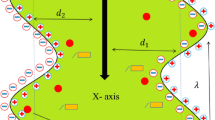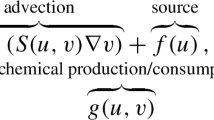Abstract
The dimorphic yeasts Candida boidinii and Yarrowia lipolytica were applied as model organisms to study mycelial growth. A mathematical model of hybrid cellular automaton type was developed to analyze the impact of different biological assumptions on the predicted development of filamentous yeast colonies. The one-dimensional model described discrete cells and continuous distribution of nutrients. The simulation algorithm accounted for proliferation of cells, diffusion of nutrient, as well as biomass decay and recycling inside the mycelium. Simulations reproduced the spatio-temporal development of C. boidinii colonies when a diffusion-limited growth algorithm based on the growth of pseudohyphal cells was applied. Development of Y. lipolytica colonies could only be reproduced when proliferation was restricted to the colony boundary, and cell decay and biomass recycling were incorporated into the model. The results suggested that cytoplasm, which served as the secondary nutrient resource, had to be translocated inside the hyphal network.






Similar content being viewed by others
Abbreviations
- A :
-
Growth field area (cm2)
- c N :
-
Nutrient concentration (mg mL−1)
- D :
-
Diffusion constant (cm2 s−1)
- DW:
-
Dry weight fraction of wet biomass
- d C :
-
Cell diameter (cm)
- h :
-
Height of the growth field (cm)
- i :
-
Index of a lattice node
- K :
-
Calibration factor for cell density from OD (cm−2)
- l :
-
Length of the growth field (cm)
- l C :
-
Length of a cell (cm)
- m C :
-
Mass of a unit cell (mg)
- n :
-
Number of lattice nodes
- n C,p :
-
Number of proliferating unit cells
- nC,p*:
-
Number of proliferating unit cells placed to lattice node (i + 1)
- n C,s :
-
Number of stationary unit cells
- OD:
-
Optical density
- r N,con :
-
Total nutrient consumption rate (mg mL−1 h−1)
- r N,main :
-
Nutrient uptake rate per cell due to maintenance (mg h−1)
- r N,prol :
-
Nutrient uptake rate per cell due to proliferation (mg h−1)
- r N,rep :
-
Nutrient replenishment rate (mg mL−1 h−1)
- R :
-
Specific nutrient uptake rate due to maintenance (mg mg−1 h−1)
- s :
-
State of a lattice node
- s C :
-
State of a cell
- T C :
-
Time constant for cell decay (h)
- Δt :
-
Time step for the continuous time scale (h)
- Δt p :
-
Replication interval (generation time) (h)
- V C :
-
Volume of a cell (mL)
- V i :
-
Volume assigned to one lattice node (mL)
- w :
-
Width of the growth field (cm)
- Y :
-
Biomass yield on nutrient (mg mg−1)
- ρ C :
-
Density of wet biomass (mg mL−1)
- σ :
-
Fraction of cells
References
Gow NAR, Robson GD, Gadd GM (1999) The fungal colony. University Press, Cambridge
Olsson L (1999) Nutrient translocation and electrical signalling in mycelia. In: Gow NAR, Robson GD, Gadd GM (eds) The fungal colony, 1st edn. University Press, Cambridge
Olsson S, Gray SN (1998) Patterns and dynamics of 32P-phosphate and labelled 2-aminobutyric acid (14C-AIB) translocation in intact basidiomycete mycelia. FEMS Microbiol Ecol 26:109–120
Jacobs H, Boswell GP, Scrimgeour CM, Davidson FA, Gadd GM, Ritz K (2004) Translocation of carbon by Rhizoctonia solani in nutritionally-heterogeneous microcosms. Mycol Res 108:453–462
Davidson FA, Sleeman BD, Rayner ADM, Crawford JW, Ritz K (1996) Large-scale behavior of fungal mycelia. Math Comput Model 24:81–87
Davidson FA, Sleeman BD, Rayner ADM, Crawford JW, Ritz K (1996) Context-dependent macroscopic patterns in growing and interacting mycelial networks. Proc R Soc Lond B 263:873–880
Davidson FA, Sleeman BD, Rayner ADM, Crawford JW, Ritz K (1997) Travelling waves and pattern formation in a model for fungal development. J Math Biol 35:589–608
Davidson FA, Park AW (1998) A mathematical model for fungal development in heterogeneous environments. Appl Math Lett 11:51–56
Davidson FA (1998) Modelling the qualitative response of fungal mycelia to heterogeneous environments. J Theor Biol 195:281–292
Falconer RE, Brown JL, White NA, Crawford JW (2005) Biomass recycling and the origin of phenotype in fungal mycelia. Proc R Soc B 272:1727–1734
Boswell GP, Jacobs H, Davidson FA, Gadd GM, Ritz K (2002) Functional consequences of nutrient translocation in mycelial fungi. J Theor Biol 217:459–477
Boswell GP, Jacobs H, Davidson FA, Gadd GM, Ritz K (2003) Growth and function of fungal mycelia in heterogeneous environments. Bull Math Biol 65:447–477
Boswell GP, Jacobs H, Ritz K, Gadd GM, Davidson FA (2007) The development of fungal networks in complex environments. Bull Math Biol 69:605–634
Meskauskas A, Fricker MD, Moore D (2004) Simulating colonial growth of fungi with the Neighbour-Sensing model of hyphal growth. Mycol Res 108:1241–1256
Meskauskas A, McNulty LJ, Moore D (2004) Concerted regulation of all hyphal tips generates fungal fruit body structures: experiments with computer visualizations produced by a new mathematical model of hyphal growth. Mycol Res 108:341–353
Walther T, Reinsch H, Grosse A, Ostermann K, Deutsch A, Bley T (2004) Mathematical modeling of regulatory mechanisms in yeast colony development. J Theor Biol 229:327–338
Walther T, Reinsch H, Ostermann K, Deutsch A, Bley T (2005) Coordinated development of yeast colonies: quantitative modeling of diffusion-limited growth—Part 2. Eng Life Sci 5:125–133
Walther T, Reinsch H, Weber P, Ostermann K, Deutsch A, Bley T (2010) Applying dimorphic yeasts as model organisms to study mycelial growth: part1—experimental investigation of the spatio-temporal development of filamentous yeast colonies (in press)
Dormann S, Deutsch A (2002) Modeling of self-organized avascular tumor growth with a hybrid cellular automaton. In Silico Biol 2:393–406
Tijhuis L, van Loosdrecht MCM, Heijnen JJ (1993) A thermodynamically based correlation for maintenance gibbs energy requirements in aerobic and anaerobic chemotrophic growth. Biotechnol Bioeng 42:509–519
Longsworth LG (1953) Diffusion measurements at 25 °C, of aqueous solutions of amino acids, peptides and sugars. J Am Chem Soc 75:5705–5709
Nicholson C (2001) Diffusion and related transport mechanisms in brain tissue. Rep Prog Phys 64:815–884
Walther T, Reinsch H, Ostermann K, Deutsch A, Bley T (2005) Coordinated development of yeast colonies: Experimental analysis of the adaptation to different nutrient concentrations—part 1. Eng Life Sci 5:115–124
Vachova L, Palkova Z (2005) Physiological regulation of yeast cell death in multicellular colonies is triggered by ammonia. J Cell Biol 169:711–717
Paul GC, Thomas CR (1996) A structured model for hyphal differentiation and penicillin production using Penicillium chrysogenum. Biotechnol Bioeng 51:558–572
Zangirolami TC, Johansen CL, Nielsen J, Jorgensen SB (1997) Simulation of penicillin production in fed-batch cultivations using a morphologically structured model. Biotechnol Bioeng 56:593–604
Datar RV, Rosen C-G (1993) Cell and cell debris removal: centrifugation and crossflow filtration. In: Stephanopoulos G (ed) Bioprocessing, vol 3. VCH, Weinheim, pp 472–503
Acknowledgments
This work was supported by DFG grant 218147.
Author information
Authors and Affiliations
Corresponding author
Rights and permissions
About this article
Cite this article
Walther, T., Reinsch, H., Ostermann, K. et al. Applying dimorphic yeasts as model organisms to study mycelial growth: part 2. Use of mathematical simulations to identify different construction principles in yeast colonies. Bioprocess Biosyst Eng 34, 21–31 (2011). https://doi.org/10.1007/s00449-010-0443-5
Received:
Accepted:
Published:
Issue Date:
DOI: https://doi.org/10.1007/s00449-010-0443-5




